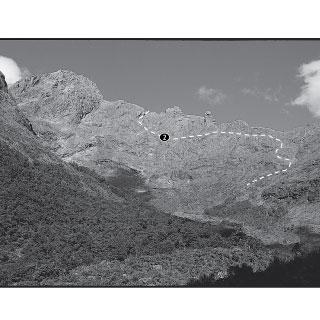The Grave–Talbot Pass was the first route to connect the head of the Hollyford River with Milford Sound. Although it was at one stage intended as a return route from Milford after walking the Milford Track, the pass is quite a difficult proposition. Wire ropes were installed above Homer Saddle and on the Esperance side to assist guided parties. Only relics of these remain – although parties sometimes belay from the massive bolts that once fixed the ropes to the rock. Treated as a climb rather than a tramp, this is a superb opportunity to develop essential Darrans skills of good route-finding and confidence on exposed ground. The route is described from west to east. Although this means more height gain, the crux ledges onto the ridge above the upper Esperance are easier to locate. The crossing is a long day – 10–12 hours – and many opt to spend a night in the upper Esperance, especially if using a rope as this will increase times.
The first crossing, from east to west, involved a more direct and frightening route over the top of Mt MacPherson and then directly down to the valley floor from the pass, double-roping using snowgrass as anchors. In January 1911, Grave, Talbot and Bert Lyttle crossed the pass as described below.
Grave Talbot Pass
Type
Altitude
1670m
Part of
Lat/lon
-44.746185,167.970786, NZ Topo Map
Topo50
CB08 019 329
Accessed from
Comments
Attribution
Craig Jefferies
UUID
5edb6416-8898-4301-965a-9f8b0d762f34
